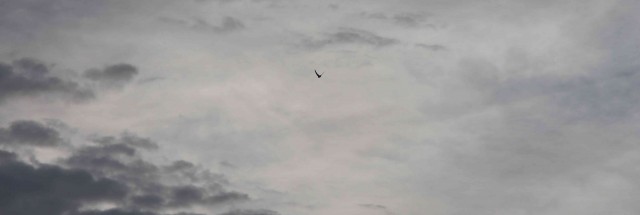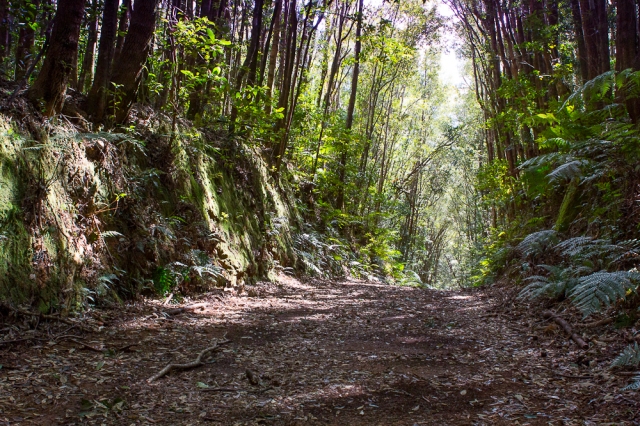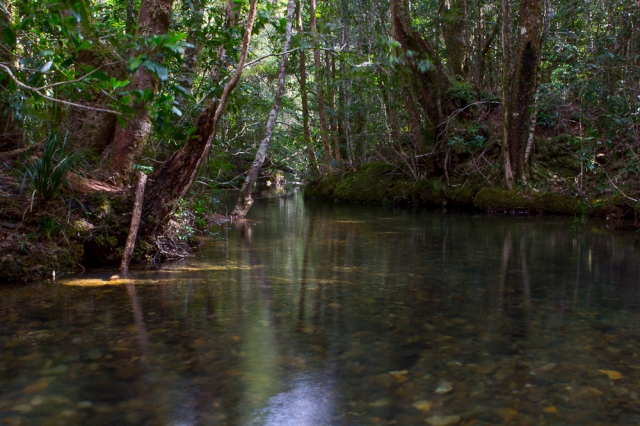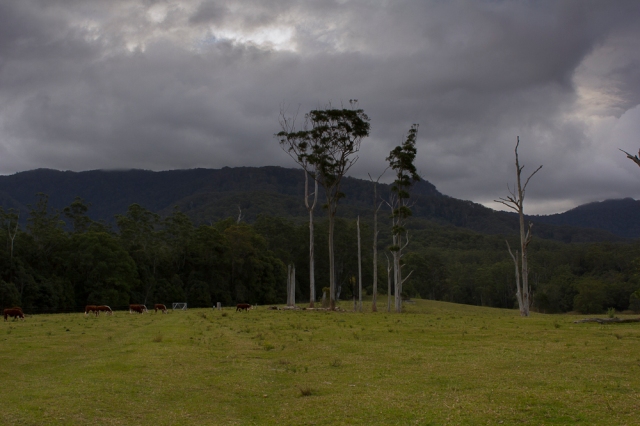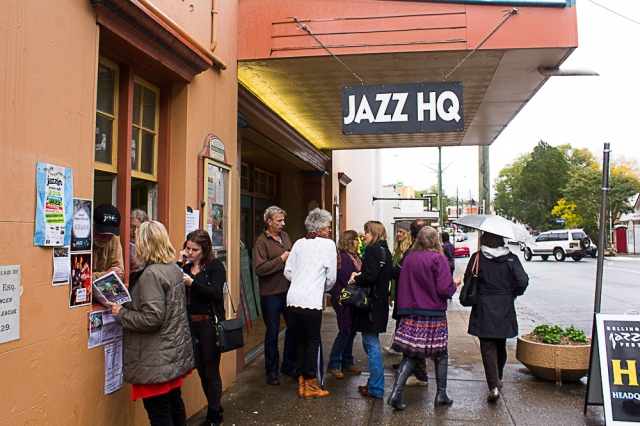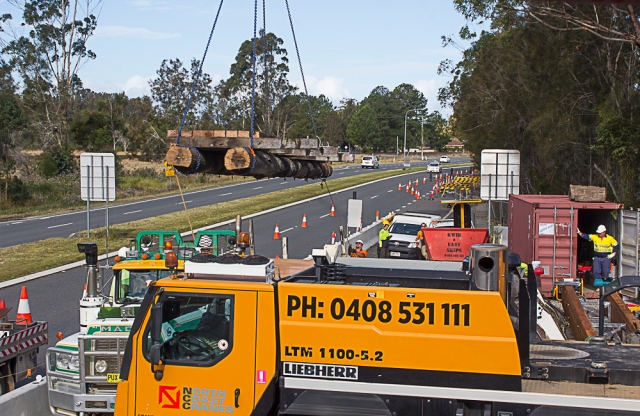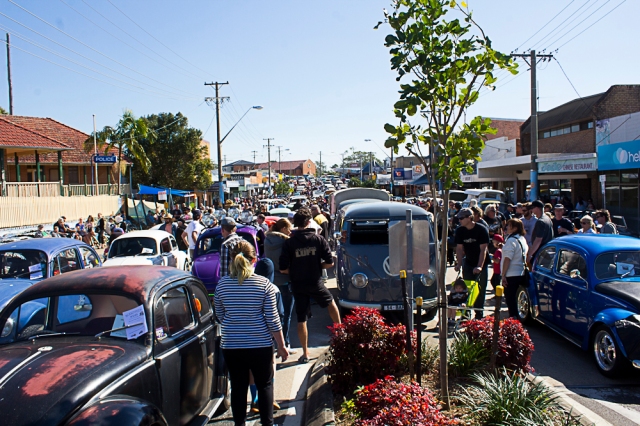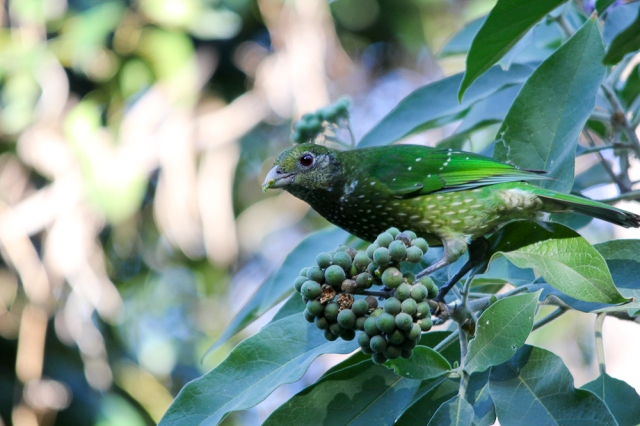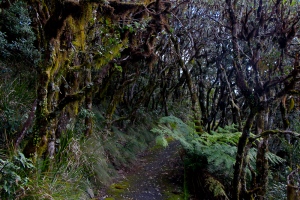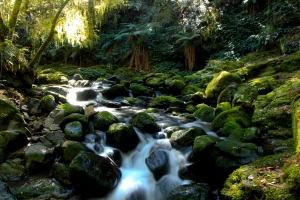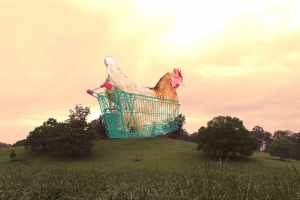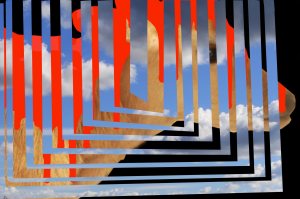This series of collages has not been created with the idea of triggering a state of epiphany for the viewer. The main reason for choosing to create these images is because I already had accumulated quite a portfolio of good photos. I could have submitted a series of land and river scapes captured in and around the Bellingen Shire of NSW but I wanted to challenge myself to come up with something a little different. I think these 10 images have achieved the personal brief I created for myself and the one intended for the satisfaction of my unit assessor.
The ideological evolution started with making some kind of comment on how man has affected his environment and how an environment has the ability to shape a community or a civilisation. From here the idea took a leap to include the theory of binary opposites and dualism – a subject that could be expressed visually with dramatic effect. From there the idea floundered a little and all I could come up with was themes or styles of expression I did not want to pursue.
“Last week I mentioned I was developing what I wanted to say – as if I felt something needed to be said, some kind of bold, insightful or disturbing commentary on life, pain, the world perhaps. I don’t want to present something pretentious or something weird for the sake of being weird, I don’t want to take an anti-art, Dada style stance and I don’t want to draw upon my experience as a social outcast living a hedonistic, masochistic and horrible life until recently. I feel if I do create something expressive the nature of my being or me being the product of my experience will ensure the message being received is one not contrived and designed for mass appeal – it will be genuine.” (week 7)
Once again drawing inspiration from my environment and of course being influenced by the ever-popular sustainability/organic/ethics movement, the theme finally settled upon was one that aims to provoke thought about what we put in our mouths. Yes, we in our human need for sustenance have been killing and eating animals for a long time and I am not advocating for a vegetarian planet. These images are simply designed to draw attention to the majesty present in all living things and perhaps even encourage the making of a connection between an animals quality of life and the quality of the product made from that animal.
Twinky, simply far North Coast post hippie rhetoric? Perhaps, or is there real merit in critical analysis of how an animal lived before it died? Recently in the media we have heard about the link between e coli present in a cows gut and what the cow has been eating. Corn, rather than feeding the hungry multitudes or even to make some of the 10,000 different products in American supermarkets, (Pollen, 2006) is being fed to cows. Corn, used as a grass substitute, to cut the growing time of a cow by as much as a quarter (Robbins, 2001) is also responsible for lowering the Ph level in the gut and consequently increasing the presence of the deadly e coli bacteria. Not only does this practice potentially poison us it is simply an inefficient way of producing food. So if we, as food producers cared more about the diet of beef cows and less about the speed at which a product can be grown we could reduce the risk of being poisoned.
To me, the condition in which many animals exist before their slaughter is nothing short of appalling. Pollen considers modern factory farming techniques as an erosion of morality, which can be blamed on economic impulse – the casuality of course being mercy toward the animals. I am not an animal liberationist and unlike the teenagers in Fast Food Nation (2002) I don’t believe I can save the world by breaking into a feedlot and trying to free a few cows. I do however believe the consumer in our society has power – power to determine what is offered for sale by the current supermarket duopoly in Australia. I also believe information to be power, if the consumers of eggs for example knew – that pressures exerted by the supermarkets forced egg producers to starve and deprive chickens of water in their last days of life to maximize egg production (Pollen, 2006)– would they buy the product of this cruelty? Current Australian statistics show consumers care about the life a chicken lives while producing eggs. Dramatic increase in sale of free range eggs is proof of this. Despite the increase in ‘free range’ egg sales, The Journal of Bioethical Inquiry believes “the ‘free-range’ eggs currently available in supermarkets do not address animal welfare, environmental sustainability, and public health concerns but, rather, seek to drive down consumer expectations of what these issues mean by balancing them against commercial interests.”(2013) So perhaps there is still work to be done in order to advance public awareness and to align the ethical standards applied to media friendly animals with the animals we rely upon as food.
In a round about way that is what the 10 images I have submitted aim to do. For this assignment I photographed all kinds of cute baby farm animals in a shopping mall. There were children feeding baby cows, pigs and chickens as part of Christmas public relations exercise. What the children did not know and what their parents would not tell then even if they did know is that those same animals somewhere in Australia were getting their beaks sliced off with a hot blade, fed antibiotics and forced to exist in the case of the chicken in a space measuring 20cm by 20cm (and called free-range). I know you cannot force someone to care about these issues (supermarket and food producers don’t want you to) but perhaps the chickens, cows and pigs of the Western world have suffered from a problem of image– this set of collages is aimed at adjusting the way we perceive our food!
Parker, C Brunswick, C and Kotey, J (2013) The Happy Hen on Your Supermarket Shelf What Choice Does Industrial Strength Free-Range Represent for Consumers? Journal of Bio-ethical Inquiry Volume 10 No 1 – Accessed online December 24th 2013 http://humanechoice.com.au/Resources/Documents/The%20Happy%20Hen%20on%20Your%20Supermarket%20Shelf_Journal%20of%20Bioethical%20Inquiry_Early%20Online%20Published%20Version.pdf
Pollan, M (2006) The Omnivore’s Dilemma: The Search for a Perfect Meal in a Fast-food World Accessed online 18th December 2013 http://books.google.com.au/books?hl=en&lr=&id=CBRRIoqyc-EC&oi=fnd&pg=PA1&dq=The+Omnivore%E2%80%99s+Dilemma:+A+Natural+History+of+Four+Meals&ots=fn2N7Pk_0X&sig=h6qgOjzycG2fo26NJKFKTpuvlrM#v=onepage&q&f=false
Robbins, John (2001)The Food Revolution: How Your Diet Can Help Save Your Life and Our World Accessed online 17th December 2013 http://sanjosepby.org/documents/food-revolution.pdf

